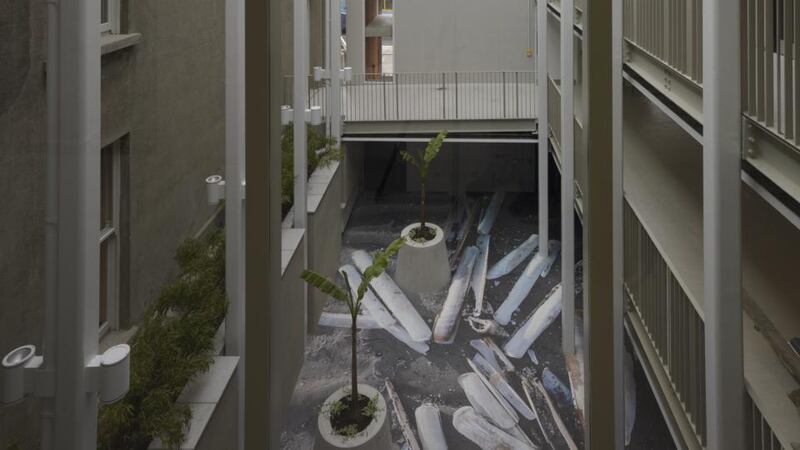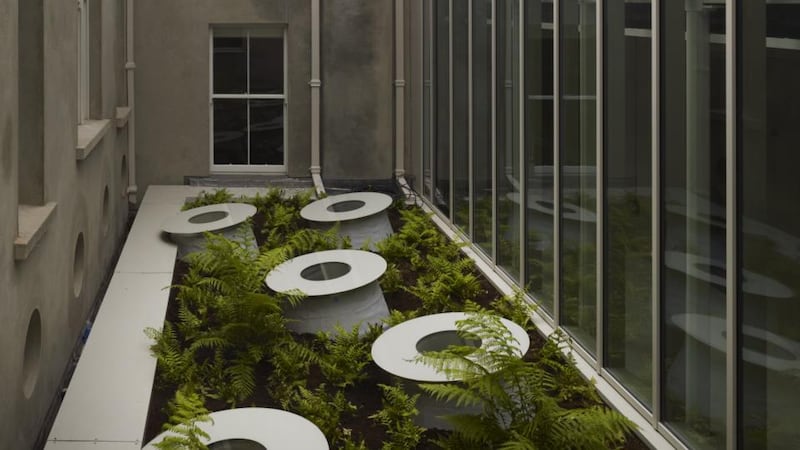While it may be imperative to keep quiet in libraries, there is no need for them to be sombre, joyless settings. Dún Laoghaire Rathdown County Council's new and lesser-known library in Blackrock – upstaged somewhat by the vast arts centre on the seafront a mile up the road by Carr Cotter & Naessens Architects – is a delightfully layered space punctuated with funnels in the ceiling descending from a fern-rich courtyard.
As I arrive there is a girl in pink trousers sitting on a high step-come-seat, a private space in an open arena, while her friends are seated a few feet above her on the other side of a glass screen. Meanwhile, people staring into computers overlook the scene from a mezzanine connected into the space through a glass partition.
From the front door, these multilayers in the library are all visible: the ramps, half-floors and mezzanine. The building is the central part of a triple-fronted edifice created from a former library, town hall and fire station and recomposed by McCullough Mulvin Architects. The library has finally been completed after a boom-recession-recovery journey.


Old and new
"It stood for around two years as a building site with water falling through the roof and swimming pools in the foundations," says architect Niall McCullough. Luckily, it was "picked up again by great contractors" called Collen Construction.
Finished just a few months ago, the time seems right to catch this quieter quarter of Blackrock village.
“The whole area has been improved by the new library,” says a man passing, clutching books. The contented library-customer is standing outside a new tearoom with walls filled with shelves of exotic and standard brews. The 5pm bell rings and the beauty-school class marches out of Blackrock Institute of Further Education in the middle building.
The oldest of the three Victorian structures is the central one built as a town hall in the mid-1800s when Blackrock was a separate borough. The late 1800s fire station followed and then the 1905 Carnegie library. They had been out of use for many years when the Department of Education made a deal with Dún Laoghaire Rathdown council to take on the buildings, restore them as a college and a new and bigger library.
Three buildings
“The project was right up our street in a mix of old and contemporary – based on the idea of trying to navigate a way between them,” says McCullough. “The finished project had to be “seamless” in the sense that the combination of old and new provided a single work of architecture.”
Essentially the three buildings were linked by a new block along the back of the site – a circulation space to carry people from one part to another – which turns towards the front to become part of the contemporary facade between the college and old fire station, now a cafe open to all.
The former town hall council chamber was interrupting circulation at the centre back so it was decided to airlift it to one side (a move challenged to An Bord Pleanála). This now sits behind the library looking out to sea and skyward through a generous lantern.
Reawaken the old
The building won the Irish Georgian Society Conservation award (jointly with Derry Guildhall), recognising that to reawaken the old it can be necessary to shift things about and inject the present day while also cherishing the old parts. In this building, that included swathes of decorative plaster. Spanning centuries made for an interesting time-frame on the build: “New and old went at a different pace. While the new part was erected according to a steady schedule the period pieces were cared for by experts who would advise: ‘It will be ready when it’s ready’.”
The attitude of plaster restorers – Seamus O’hEocha, from Galway, who did the internal work, and Oldstone Ltd, who worked on the exterior – became infectious: “Plaster turned into a grand passion,” says McCullough, pointing out that external plaster is not a highly developed form in our land of brick and stone.
While old and new (as interlinking L-shaped structures) are distinctive – as are certain spaces such as the great room on the first floor of the town hall opened for the first time in a century – period parts punctuate the new.
After stripping back layers some elements discovered were not recovered, including a panel of paint in the library (causing some disquiet), a bracket which has been left exposed in a window and a cast-iron column and pediment left in a wall. Such surprises are in the new parts too, especially the two courtyards: one with the ferns and funnels and the other a vinyl floor, by Forbo, printed with a vast sea scene of sand and oversized shells at the base of an atrium. This beachy pool-room is planted with palm trees, against which a female student leans while two guys pot balls.
As with the library, there is a sense of joy in the use of this building, something witnessed in the buzzing beauty class too. So a mix of clients, users, buildings and centuries have come together to take this part of Blackrock into its next few centuries. "Everybody had a will to make it work," says architect Valerie Mulvin. Now it's over to the users.











